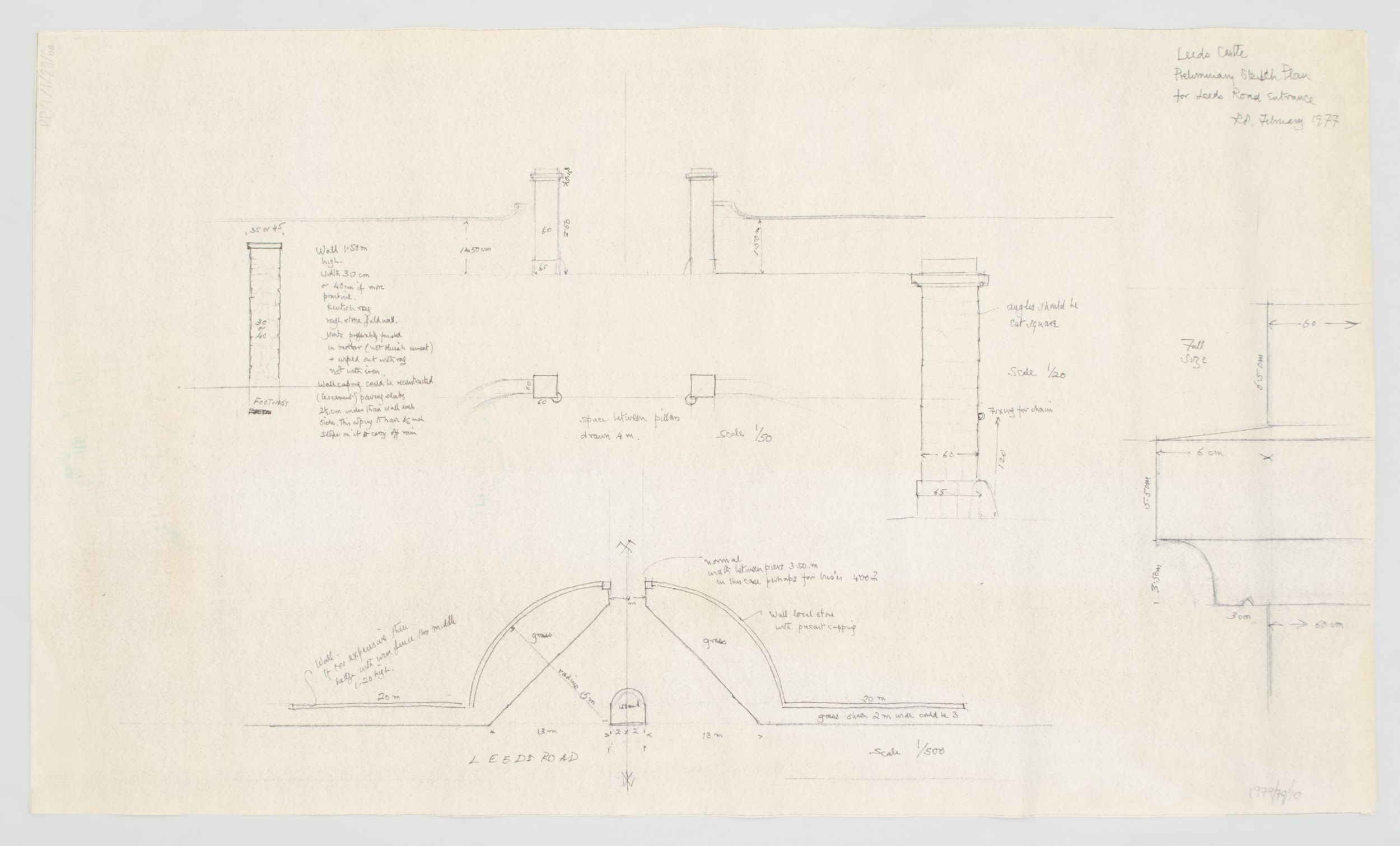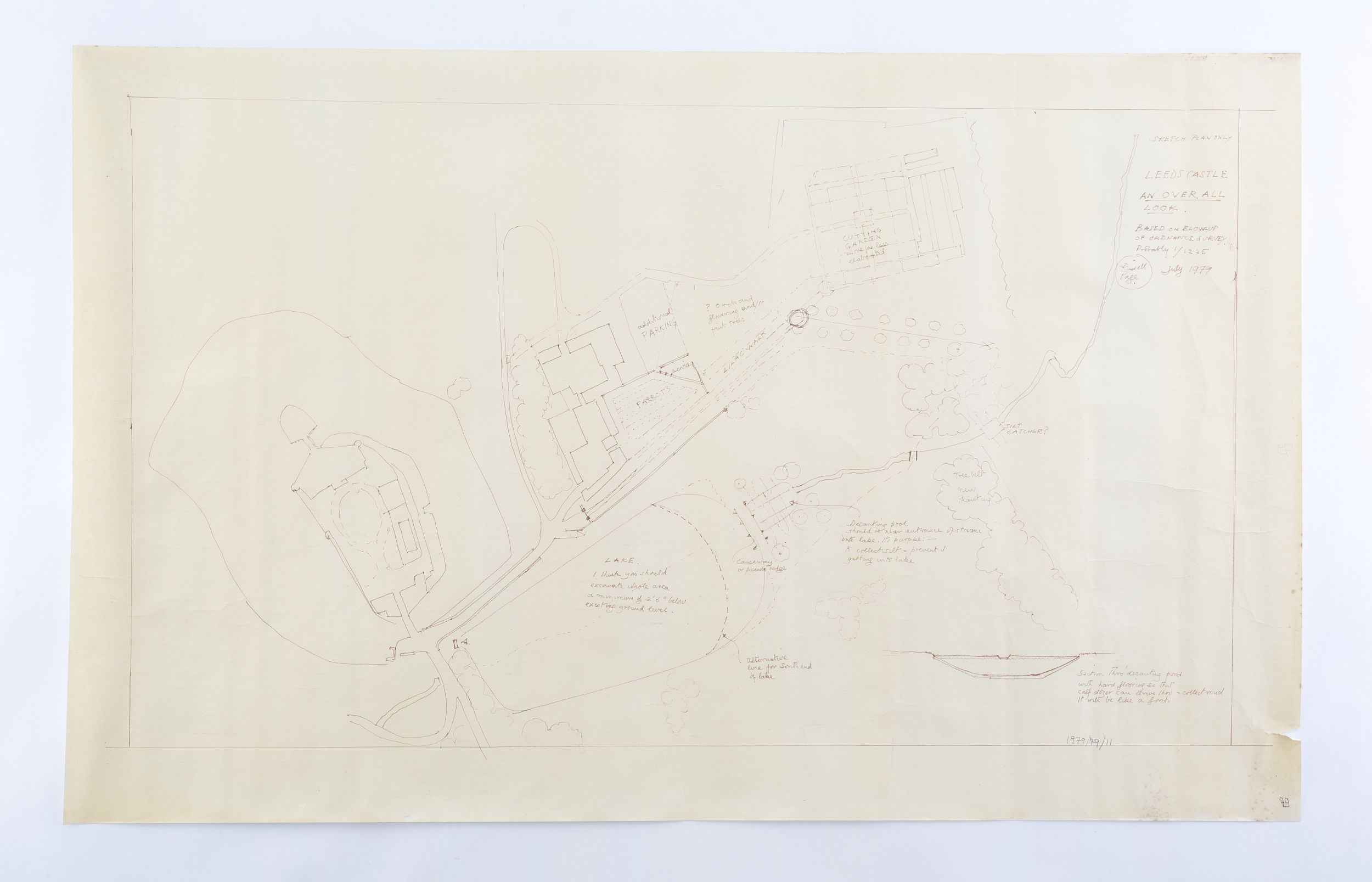Russell Page worked at the historic Leeds Castle from the 1930s to the 1980s, creating water gardens and a swimming pool, as well as a walled flower garden on a tricky site and a vast new lake aptly called the Great Water.
Leeds Castle, Broomfield, Kent, England
1956 to 1979
Archive of Garden Design Ref: RP/1/1/20
Leeds Castle is notable among Russell Page’s projects not only for the impact of his designs, which included creating a 450m long lake, but because he worked there, on and off, throughout his entire career.
In the mid-1930s, Page was asked to carry out landscaping at the estate by Lady Baillie, who had purchased the property in 1926 (with her second husband Arthur Wilson-Firmer; she married Sir Adrian Baillie in 1931). The estate had a long history. Home to a Norman castle, which had evolved over the centuries to become a royal palace, it first passed into private hands in the mid-16th century, when Henry VIII granted it to Anthony St Leger. From this point on, the living accommodation, sited on an island surrounded by a moat, went through various iterations: the early castle buildings were initially rebuilt as a Jacobean mansion, the outer appearance of which was substantially modified in 1749, but this too was demolished in the 1820s and a ‘New Castle’ built in a pseudo-medieval style.
From the late 1920s onwards, Lady Baillie continued to make further alterations to the interior of the castle, working with architect Owen Little and interior designers Armand-Albert Rateau and Stéphane Boudin to create a suitably impressive setting for her legendary entertaining (her guests included politicians, film stars and royalty). She also set about transforming the grounds. The estate extends to more than 350 acres of parkland and woodland; cutting through it is the River Len, and a collection of connected streams and ponds. To the west of the river is a steep, bowl-shaped bank, while the land to the east rises more gently.
Attention was focused mostly on the roughly 15-acre plot radiating out from the moated castle. Page assisted with much of this, although there are no documents in the Russell Page archive that relate to his pre-1950s work at Leeds Castle. It was one of his first professional roles and may well have come about thanks to Stéphane Boudin, with whom Page had worked at Ditchley Park in 1935. Page is credited with designing the new oval-shaped drive leading up to the main entrance to the house, as well as new plantings around the castle. He also oversaw the addition of a swimming pool, deploying a device he would often use of disguising it behind yew hedges.
At some point, Page also worked on the creation of a naturalized spring garden along the banks of the stream and ponds which ran off the River Len to the north-west of the castle (Francois Goffinet was responsible for redesigning this planting in the late 1980s). The only drawings to show designs for these waterways are those for a bridge over the Cedar Pond (RP/1/1/20/18 and RP/1/1/20/4), which was constructed in the 1960s (Page’s notes on RP/1/1/20/4 suggest that it was to replace an earlier rotten bridge, although no footbridge appears to have been previously marked on ordnance survey maps). Around the same time, Page helped to create a canal, surrounded by a wilderness of grass and felled trees, to home Lady Baillie’s much-loved waterfowl. A surviving reference to this work exists in the design for a duck pond house (RP/1/1/20/2).
The earliest of the drawings for Leeds Castle in the archive relate to a proposed new lake in which there would be a rectangular island garden (see RP/1/1/20/1, RP/1/1/20/3 and RP/1/1/20/19). The shape of the lake, and its position in relation to driveways, suggests that these are early designs for what would become the Great Water, the lake which was created by flooding the valley of the river Len to the south of the castle. This area of land had been flooded before, when used as a water defence during the medieval period, but maps suggest that the current Great Water was not formed until the re-landscaping of the property in the 1970s, twenty years after Page’s initial drawings. The earlier suggestions for a mount and garden were not included in the final realisation of the new lake, however.
The later 1970s was a busy time at Leeds Castle. Lady Baillie had died in 1974, leaving the estate to the Leeds Castle Foundation so as to ensure it would be preserved permanently. In 1976, following necessary alterations (such as adding new parking areas) the castle opened to the public. As part of these modifications, Page not only oversaw the construction of the Great Water but transformed a walled kitchen garden, overlooking the new lake, into a more formal flower garden. It was not an easy undertaking. As his notes on an early plan (RP/1/1/20/20) make clear:
There is an 8 foot drop East West and a gentler slope N. S. A shapeless site with slopes falling two ways. In no way should it ever be seen as a whole. Any design you could see all at once would mean a lot of stone retaining walls & steps & would never make sense on this piece of ground with the shape it has. Only solution – break it up into very large beds – use diagonals for paths (gentler slopes). Plant in Sissinghurst jungle fashion. Lots of old fashioned & floribunda roses – lilacs [syringas] iris paeonies – other low maintenance perennials & small flowering or foliage low shrubs of labyrinth of plants which you wander [amongst?]. At best it would be the contemporary [ideal?] cottage garden.
It’s no flower garden for Leeds Castle – which should not have a flower garden anyway.
THIS SITE IS FOR THE BIRDS.
The work went ahead, however, and the new garden was finished in 1980. Called the Culpeper Garden, after the seventeenth-century owners of Leeds Castle, Page followed his proposed solution and broke down the irregular plot into a series of geometric, box-edged beds filled with a selection of English cottage garden plants, divided by brick paths. According to Gabrielle van Zuylen, “Page’s method of planting the Culpepper garden was practical and fast” (115). As she goes on to explain:
He drew up his plant list alphabetically and sent instructions to Leeds to have the flats of plants laid out in twenty-six alphabetical rows. He arrived at the castle armed with a long stick, and, assisted by seven gardeners, simply pointed to the easily found plants, and into the soil they went. The garden was made in one day, and not one plant was subsequently repositioned. (115)
The Culpeper Garden can still be seen as Page intended.
Literature
“Leeds Castle.” Historic England, https://historicengland.org.uk/listing/the-list/list-entry/1000184. Accessed 8 July 2020.
van Zuylen, Gabrielle and Marina Schinz. The Gardens of Russell Page. Frances Lincoln Ltd, 2008.
Related material in the Archive of Garden Design
RP/3/1/3: Leeds Castle, Handwritten text.
Related material elsewhere
There are several aerial photographs, taken between 1923 and 1948, available to view on the Britain from Above website (including: EPW009215; EAW017623; EPW038119; EPW009216; EPW018638; EAW004771; EAW004768; EAW004772; and EAW004769), https://britainfromabove.org.uk/en. Accessed 8 July 2020.






















